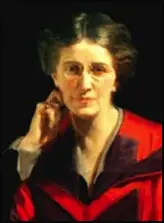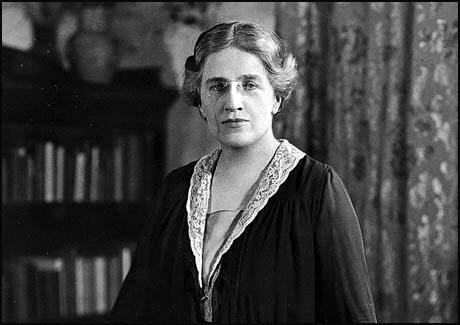Louisa Martindale (1873-1966)

Louisa Martindale, the first child of William Martindale and his second wife Louisa Spiver Martindale, was born in Leytonstone, Essex, on 30 October 1872. In her youth her mother had read a book by Mary Wollstonecraft called Vindication of the Rights of Women (1792). Louisa agreed with Wollstonecraft that girls should have the same educational opportunities as boys. However, this was very difficult, as there were few schools in the country that provided a good academic education for girls. At first she tried to start her own school for girls in Lewes, but she experienced so much opposition from the people in the town she decided to abandon the project. In 1885 she moved to Brighton so that her two daughters might attend the Brighton High School for Girls.
Once she had settled in the town, Louisa Martindale began to play an active role in local politics. She was a prominent member of Brighton's Women's Co-operative Guild and wrote several pamphlets on the movement. Louisa also helped start a Brighton branch of the Suffrage Society and with the assistance of Marie Corbett helped form a woman's suffrage group within the Liberal Federation.
Louisa's home in Brighton became an important centre of the women's movement in Sussex and it was here that Margaret Bondfield, then a young shop girl, had her first chance to develop her political ideas. Louisa Martindale was a loyal supporter of the National Union of Women's Suffrage Societies (NUWSS).
From an early age it had been decided that Louisa should become a doctor, and at 17 she was sent to Royal Holloway, University of London in Egham and obtained her London Matriculation in 1892. She then entered the London School of Medicine for Women in 1893, gaining her MB in 1899, and her BS. In 1900 she went north to Hull as an assistant to Dr. Mary Murdoch, the beginning of her professional life. Murdoch and Martindale worked closely as they were partners in their business. In 1902 they went on a cycling holiday together visiting Vienna, Berlin and Switzerland. They were in partnership until 1906.
After five years in Hull, in 1906 Martindale gained her Doctor of Medicine and returned to Brighton and became the town's first GP. Soon afterwards she was asked to join the Lewes Road Dispensary for Women and Children as a visiting medical officer.
Martindale was a member of the national executive of the National Union of Women's Suffrage Societies and although not a militant, she did help to hide members of the WSPU from the police. Louisa wrote a pamphlet on prostitution for the NUWSS, Under the Surface (1909), but when it was published members of the House of Commons described it as obscene and called for it to be withdrawn. During the First World War she served with the Scottish Women's Hospitals at Royaumont Abbey in France.
In 1920 she was instrumental in the setting up of the New Sussex Hospital for Women in Windlesham Road, Brighton. She left Brighton and Hove in 1922, moving to London to start a Surgical Consultant Practice but continued to operate part-time at the New Sussex Hospital. After moving to London as a Consultant Surgeon, Louisa soon became known as honorary surgeon at the Marie Curie Hospital. In 1931, Martindale was elected as President of the Medical Women's Federation. She was appointed C.B.E. that same year.

In 1933 she was elected a Fellow of the Royal College of Obstetricians and Gynaecologists. In 1937, Martindale was appointed to the Council of the Royal College of Obstetricians and Gynecologists as the first woman member in history.Louisa wrote two books on her medical career: The Woman Doctor and Her Future and The Woman Surgeon.
Martindale secured a long and distinguished life and career in medicine, carrying out over 7000 operations. Her work brought her respect and acknowledgment from both her colleagues and her patients: she was made a Fellow of the Royal College of Obstetricians in 1933, and was a member of the Royal Society of Medicine. Eventually she became a specialist in the early treatment of cervical cancer by X-ray and she later lectured extensively throughout the UK, the United States, and Germany.
Louisa wrote two books on her medical career: The Woman Doctor and Her Future (1922) and an autobiography The Woman Surgeon (1951) where she wrote about her long-term relationship with Ismay FitzGerald.
Louisa Martindale retired from practice in 1947 and died in her home in London on 5th February 1966, aged 93.
Primary Sources
(1) Hilda Martindale, From One Generation to Another (1944).
My sister (Louisa Martindale) joined the staff, which was heavily overworked, some eight thousand patients being seen yearly. But she soon discovered that all the more serious medical and surgical cases needing in-patient treatment had to be sent to the County Hospital. As there seemed no chance of a medical woman being put on the staff of that hospital, my mother, sister and others interested in the Dispensary felt that the only solution to the problem was to take a house adjoining and open there a small hospital of twelve beds for medical and surgical cases.
The opposition to this scheme was at first very strong. It seemed impossible to get money. Everything was wanting except the patients, and they were always there with their insistent demand to get a 'lady' to look at them because she would 'understand'. My mother became chairman of the committee… bringing all her organizing power, her clear sense, and unshakeable faith, to the service of this building. In due course this little hospital grew to be one of the five general hospitals for women in Britain officered by women doctors.
In 1911 and my sister became the senior surgeon. Undoubtedly all the original work of establishing the hospital was due to my mother and also the breaking down of opposition and prejudice; the development of the hospital and its removal to Windlesham House came four years after her death and was due to my sister, who was recognised on all sides as the Founder of the New Sussex Hospital as it then came to be called.
(2) Octavia Wilberforce, Octavia Wilberforce: Autobiography of a Pioneer Woman Doctor (1990)
Three or four doctors in surrounding villages had seen Janet at my request and they each assured me that her cough was nothing serious. They said it was magnified in her own mind by the fact that her mother had died of consumption. They were wrong. Janet herself accepted the cough as more or less normal and thought I was being unduly fussy.
I insisted on her seeing a woman doctor, Dr. Louisa Martindale, a friend of Elizabeth Robins. The X-ray confirmed that she had tuberculosis. I was enraged by the delay in not catching the trouble at an earlier stage. I took her to Brompton Hospital. 'Too advanced for admission'. I boiled over with fury; after all, if I with only my eyes and no stethoscope had been able to diagnose all those months ago I could be a better doctor myself.
In a mood of complete despondency I grumbled to Elizabeth Robins. In my abysmal ignorance of what medical training involved, I told her that my observations and common sense had proved me right in diagnosis. 'Why couldn't I become qualified and be a doctor'. She turned and looked at me with flashing eyes and an expression I'd never seen in them before and burst out: 'Now that would be a worthwhile life. My father wanted me, urged me, to be a doctor,' and with passionate enthusiasm, 'It's the greatest profession in the world.'

